Beans Technical
Description
The common bean, Phaseolus vulgaris, is an herbaceous annual plant in the family Fabaceae which is grown as a pulse and green vegetable. The common bean can be bushy, vine-like or climbing depending on the variety being grown. The leaves grow alternately on the stems, are green or purple in color and are divided into 3 oval leaflets with smooth edges. The leaves can grow 6–15 cm (2.4–5.9 in) long and 3–11 cm (1.2–4.3 in) wide. The common bean produces white, pink, lilac or purple flowers which are approximately 1 cm (0.4 in) in diameter, and bean pods 8–20 cm (3.1–7.9 in) long and 1–1.5 cm (0.4–0.6 in) wide which can range in color from green to yellow or black to purple. Each pod contains 4-6 smooth, kidney-shaped beans. Common bean plants are annual plants and last only one growing season and range greatly in size from the bushy varieties 20–60 cm (7.9–24 in) in height; to vines or runner beans which can reach 2–3 m (6 ft 7 in–9 ft 10 in) in length. The common bean includes many varieties and may be referred to as bush bean, dry bean, dwarf bean, field bean, French bean, snap bean, garden bean, haricot bean, kidney bean, pole bean or string bean. The plant originates from the Americas.
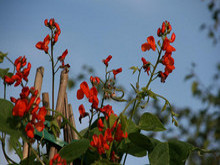
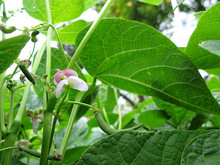
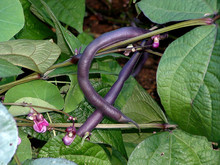
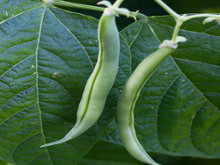
Uses
The common bean is used as a pulse and green vegetable eaten fresh or cooked. The beans can be dried, cooked in sauce and canned.
Propagation
Basic requirements
Common beans are warm-season crops and should be planted after all danger of frost has passed and the soil has warmed. Beans will grow best at soil temperatures between 15.5 and 29°C (60–85°F) and are sensitive to cold temperatures and frosts. Beans will grow best in a fertile, well-draining soil with a pH between 6.0 and 6.75 Beans will perform best in full sunlight.
Varieties
Common beans can either be bush or pole varieties. Bush beans will grow erect without any support and require less care than pole varieties. Pole beans grow vertically on a support and are generally easier to harvest. Most type of bean are now available as both bush and pole varieties. Some green bean varieties may be referred to as “string” beans. This name is a reference to older varieties which produced a stringy fibre along the seam of the pod. Modern cultivars were bred which did not produce this substance and which are commonly referred to as “snap” beans due to the ease with which the green pods can be snapped in two.
Sowing seeds
Beans should be direct seeded in the garden in when the soil has reached a temperature of at least 15.5°C (60°F), with the optimum temperature for germination being between 15.5 and 29°C (60–85°F). Planting at cooler temperatures leads to slow germination and promotes seed rotting. Seeds should be planted 2.5–3.5 cm (1–1.5 in) deep. Bush beans should be planted 5–10 cm (2–4 in) apart allowing 0.6–0.9 m ( 2–3 ft) between rows. Pole beans can be planted in both row and hills. In rows, seeds should be spaced 15–25 cm (6–10 in) apart allowing 0.9–1.2 m (3–4 ft) between rows. For a continuous harvest of beans over the summer months, make new plantings every 2–3 weeks.
Poles and trellises
Pole beans should be provided with a pole or trellis to climb on to support the weight of the pods and allow light to penetrate to all parts of the plant, helping to prevent disease. Bean poles should have a rough surface to help the plant to grip and should be 1.8–2.1 m (6–7 ft) long. Three or four poles can be used to form a tripod onto which the plants can be trained. Bean trellises can be constructed easily using posts (or a tripod arrangement of poles), wire and twine. Position a post at either end of the area in which you wish to plant a row of beans and connect with two lengths of wire. The first wire should be approximately 13 cm (5 in) from the ground, and the second 1.5–1.8 m (5–6 ft) from the ground. Finally, use the twine to create a V-shaped trellis by tying the twine to the bottom wire, bringing it up to the top wire and looping it back down around the bottom wire. Continue to zigzag the string all the way along the wires to the second support before tying the twine off. A rough textured twine is best as it will encourage the plant to climb and twine around it. Pinch back the growing tips of the plants once they reach the top support to encourage the plant to branch.
Harvesting
Beans are generally ready for harvest approximately two weeks after bloom. The beans should be harvested just before the seeds are mature and before they form bumps on the pod. The pods should be firm and snap when they are bent. Pick beans every 2–3 days to ensure the plants remain productive. Pinch beans rather than pulling to avoid damaging the plant. Cut pole beans from the plant using scissors.
References
CABI Crop Protection Compendium. (2008). Phaseolus vulgaris datasheet. Available at: http://www.cabi.org/cpc/datasheet/40626
Drost, D. (2010). Beans in the Garden . Utah State University Cooperative Extension. Available at: https://extension.usu.edu/files/publi….
Lerner, B. R. (2001). Growing Beans in the Home Vegetable Garden. Purdue University Cooperative Extension Service. Available at: http://www.hort.purdue.edu/ext/ho-175…
Category : Fungal
Alternaria leaf spot
Symptoms
Small irregular brown lesions on leaves which expand and turn gray-brown or dark brown with concentric zones; older areas of lesions may dry out and drop from leaves causing shot hole; lesions coalesce to form large necrotic patches
Cause
Fungus
Comments
Disease emergence favored by high humidity and warm temperatures; plants grown in nitrogen and potassium deficient soils are more susceptible
Management
Plant beans in fertile soil; foliar fungicide application may be required
Anthracnose
Symptoms
Small, dark brown to black lesions on cotyledons; oval or eye-shaped lesions on stems which turn sunken and brown with purple to red margins; stems may break if cankers weaken stem; pods drying and shrinking above areas of visible symptoms; reddish brown spots on pods which become circular and sunken with rust colored margin.
Cause
Fungus
Comments
Disease transmitted through infected seed; fungus can survive in crop debris in soil and reinfect crop the following season.
Management
Plant resistant varieties; use certified disease free seed; avoid sprinkler irrigation, water plants at base; plow bean crop debris into soil.
Bean rust
Symptoms
Initially the symptoms appear as small yellow/white spots on leaves. Later the spots become enlarged and shows raised brick red rust pustules (uredinia). Normally this pustules are surrounded by a yellow halo. Premature leaf drop may occur if the disease is severe.
Cause
Fungus
Comments
Spores (urediniospores) spread from one field to another by air. The black teliospores formed at the end of the crop season overwinter in the field and act as inoculum for next season crops.
Management
Grow available resistant varieties. Remove and destroy the infected crop debris. Follow crop rotation. Keep the field free from weeds. If the disease is severe, spray suitable fungicide.
Black root rot
Symptoms
Elongated red-purple lesions on root tissue which turns dark gray to black; lesions coalesce to form large dark areas on roots and stems; deep lesions can cause stunted growth, wilting leaves, defoliation and plant death.
Cause
Fungus
Comments
Fungus survive in plant debris in soil.
Management
Rotate crops with non-susceptible grasses; avoid excess irrigation or drought stress.
Fusarium root rot
Symptoms
Young plants stunted with chlorotic leaves; older plants with chlorotic leaves and some leaf drop; severely decayed roots which are hollow and dry.
Cause
Fungus
Comments
Fungus can survive in soil for several years.
Management
Practice long term crop rotation; avoid over or under watering plants; some bean varieties exhibit some tolerance.
White mold (Sclerotinia timber rot)
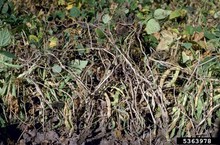
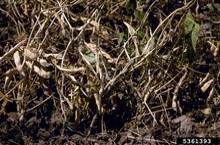
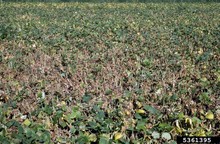
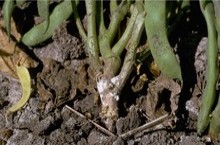
Symptoms
Flowers covered in white, cottony fungal growth; small, circular, dark green, water-soaked lesions on pods leaves and branches which enlarge and become slimy; cottony white growth may be visible on lesions during periods of high humidity; death of branches and/or entire plant.
Cause
Fungus
Comments
Fungus can survive in soil for in excess of 5 years; disease can be spread by wind, contaminated irrigation water and by infected seeds.
Management
There is no true immunity to white mold in any bean varieties; rotate crops with non-hosts like cereals and corn; plant rows parallel to direction of prevailing winds to prevent spread of disease from secondary hosts nearby; avoid excessive nitrogen fertilizer; use a wide row spacing.
Category : Bacterial
Bacterial blight
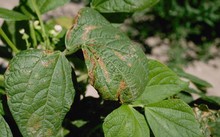
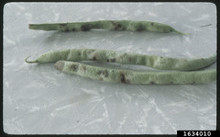
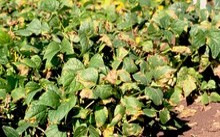
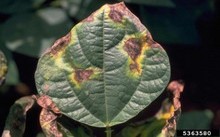
Symptoms
Water-soaked spots on leaves which enlarge and become necrotic; spots may be surrounded by a zone of yellow discoloration; lesions coalesce and give plant a burned appearance; leaves that die remain attached to plant; circular, sunken, red-brown lesion may be present on pods; pod lesions may ooze during humid conditions.
Bacterium
Cause
Comments
Disease can be introduced by contaminated seed; bacteria overwinters in crop debris; disease emergence favored by warm temperatures; spread is greatest during humid, wet weather conditions.
Management
Plant only certified seed; plant resistant varieties; treat seeds with an appropriate antibiotic prior to planting to kill off bacteria; spray plants with an appropriate protective copper based fungicide before appearance of symptoms.
Bacterial brown spot
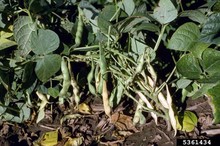
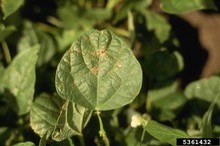
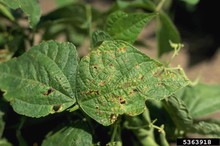
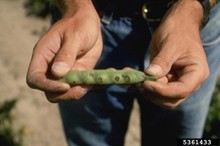
Symptoms
Small, dark brown necrotic spots on leaves which may be surrounded by a zone of yellow tissue; water soaked spots on pods which turn brown and necrotic; pods may twist and distort in area of infection.
Cause
Bacterium
Comments
Bacterium overwinters in crop residue; disease more severe when foliage is wet for extended periods.
Management
Plant only certified seed; rotate crops regularly; remove crop debris from field after harvest.
Halo blight
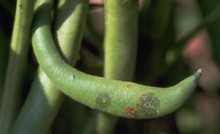
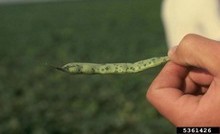
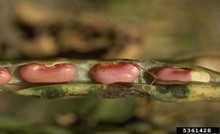
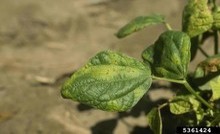
Symptoms
Small water-soaked spots on underside of leaves which turn necrotic and become visible on upper surface; lesions may develop an area of chlorotic tissue around the spots; lesions on expanding leaves may cause distorted leaves; red-brown lesions may be visible on pods; pod lesions may ooze or may turn tan in color.
Cause
Bacterium
Comments
Bacterium survives in seeds and crop debris and enters plants through natural openings such as stomata and is spread by splashing water and soil movement.
Management
Plant disease free seed or treat seed with an antibiotic to reduce levels of bacterium; rotate crops to non-hosts every 2 years; plow bean debris deeply in soil after harvest.
Category : Fungal, Oomycete
Damping-off
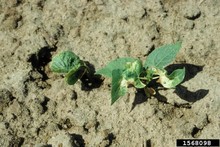
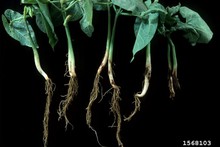
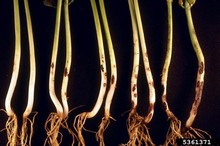
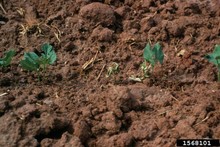
Symptoms
The pathogens attack any stage of crop beginning from seed rot; damping off of seedlings; or stunting, yellowing and death of older plants. Visible symptoms are the appearance of elongated sunken reddish-brown lesions on roots and stems at or below the soil line. Further the lesions girdle the stem, causing the death of the plant. Older plants may show little indication of the disease, although yields may be reduced. The pith may turn brick- red if invaded by the fungus.
Cause
Fungus
Comments
The pathogens are transmitted by irrigation water, soil and equipments.
Management
Follow crop rotation with non host crops. Sow the seeds in warm soil with well prepared seed bed and proper depth. Treat seeds with a suitable fungicide.
Category : Viral
Mosaic
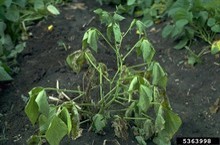
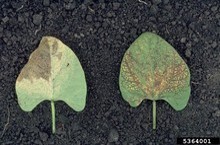
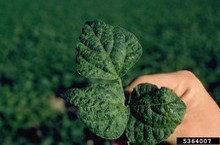
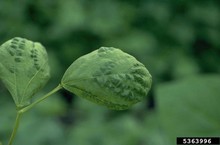
Bean common mosaic virus (BCMV), Bean common mosaic necrosis virus (BCMNV)
Symptoms
Mottled dark and light green patterns on leaves; leaves may be distorted; yellow dots may be present on leaves; growth of plant may be reduced.
Cause
Viruses
Comments
BCMV can be transmitted by seed and has a worldwide distribution; BCMNV also transmitted through infected seed but geographic range more restricted.
Management
Plant only virus-free seed; plant resistant varieties.
Aphids (Cowpea aphid, Pea aphid, etc.)
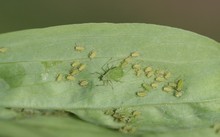
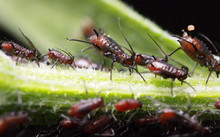
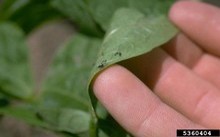
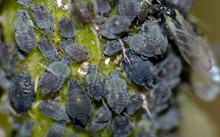
Category : Insects
Symptoms
Small soft bodied insects on underside of leaves and/or stems of plant; usually green or yellow in color, but may be pink, brown, red or black depending on species and host plant; if aphid infestation is heavy it may cause leaves to yellow and/or distorted, necrotic spots on leaves and/or stunted shoots; aphids secrete a sticky, sugary substance called honeydew which encourages the growth of sooty mold on the plants.
Cause
Insect
Comments
Distinguishing features include the presence of cornicles (tubular structures) which project backwards from the body of the aphid; will generally not move very quickly when disturbed.
Management
If aphid population is limited to just a few leaves or shoots then the infestation can be pruned out to provide control; check transplants for aphids before planting; use tolerant varieties if available; reflective mulches such as silver colored plastic can deter aphids from feeding on plants; sturdy plants can be sprayed with a strong jet of water to knock aphids from leaves; insecticides are generally only required to treat aphids if the infestation is very high – plants generally tolerate low and medium level infestation; insecticidal soaps or oils such as neem or canola oil are usually the best method of control; always check the labels of the products for specific usage guidelines prior to use.
Armyworms (Beet armyworm, Western striped armyworm)
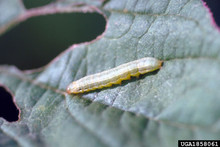
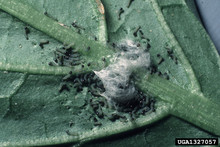
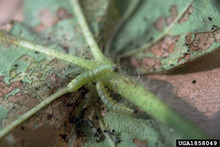
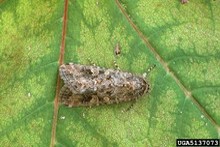
Symptoms
Singular, or closely grouped circular to irregularly shaped holes in foliage; heavy feeding by young larvae leads to skeletonized leaves; shallow, dry wounds on fruit; egg clusters of 50-150 eggs may be present on the leaves; egg clusters are covered in a whitish scale which gives the cluster a cottony or fuzzy appearance; young larvae are pale green to yellow in color while older larvae are generally darker green with a dark and light line running along the side of their body and a pink or yellow underside.
Cause
Insect
Comments
Insect can go through 3–5 generations a year.
Management
Organic methods of controlling armyworms include biological control by natural enemies which parasitize the larvae and the application of Bacillus thuringiensis; there are chemicals available for commercial control but many that are available for the home garden do not provide adequate control of the larvae.
Corn earworm
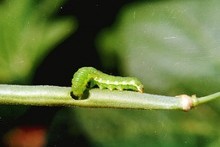
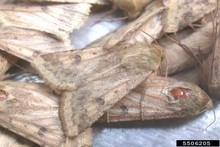
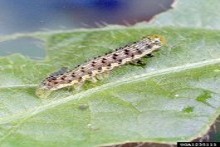
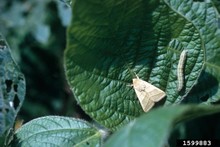
Symptoms
Larvae damage leaves, buds, flowers, pods and beans; young caterpillars are cream-white in color with a black head and black hairs; older larvae may be yellow-green to almost black in color with fine white lines along their body and black spots at the base of hairs; eggs are laid singly on both upper and lower leaf surfaces and are initially creamy white but develop a brown-red ring after 24 hours and darken prior to hatching.
Cause
Insect
Comments
Adult insect is a pale green to tan, medium sized moth; insect is also very damaging pests of corn; insect overwinters as pupae in the soil.
Management
Monitor plants for eggs and young larvae and also natural enemies that could be damaged by chemicals; Bacillus thuringiensis or Entrust SC may be applied to control insects on organically grown plants; appropriate chemical treatment may be required for control in commercial plantations.
Cutworms
Peridroma saucia Nephelodes minians and others
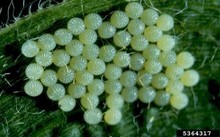
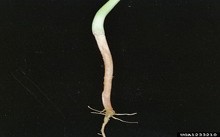
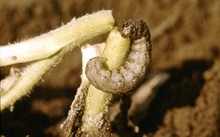
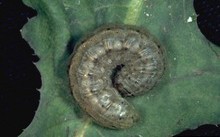
Symptoms
Stems of young transplants or seedlings may be severed at soil line; if infection occurs later, irregular holes are eaten into the surface of fruits; larvae causing the damage are usually active at night and hide during the day in the soil at the base of the plants or in plant debris of toppled plant; larvae are 2.5–5.0 cm (1–2 in) in length; larvae may exhibit a variety of patterns and coloration but will usually curl up into a C-shape when disturbed.
Cause
Insects
Comments
Cutworms have a wide host range and attack vegetables including asparagus, bean, cabbage and other crucifers, carrot, celery, corn, lettuce, pea, pepper, potato and tomato.
Management
Remove all plant residue from soil after harvest or at least two weeks before planting, this is especially important if the previous crop was another host such as alfalfa, beans or a leguminous cover crop; plastic or foil collars fitted around plant stems to cover the bottom 3 inches above the soil line and extending a couple of inches into the soil can prevent larvae severing plants; hand-pick larvae after dark; spread diatomaceous earth around the base of the plants (this creates a sharp barrier that will cut the insects if they try and crawl over it); apply appropriate insecticides to infested areas of garden or field if not growing organically.
Leafminers
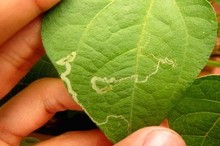
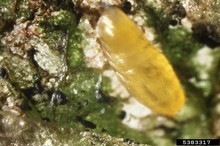
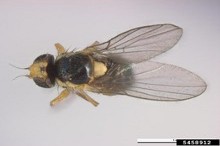
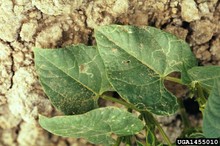
Symptoms
Thin, white, winding trails on leaves; heavy mining can result in white blotches on leaves and leaves dropping from the plant prematurely; early infestation can cause fruit yield to be reduced; adult leafminer is a small black and yellow fly which lays its eggs in the leaf; larvae hatch and feed on leaf interior.
Cause
Insects
Comments
Mature larvae drop from leaves into soil to pupate; entire lifecycle can take as little as 2 weeks in warm weather; insect may go through 7 to 10 generations per year.
Management
Check transplants for signs of leafminer damage prior to planting; remove plants from soil immediately after harvest; only use insecticides when leafminer damage has been identified as unnecessary spraying will also reduce populations of their natural enemies.
Loopers (Cabbage looper, Alfalfa looper)
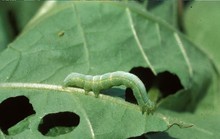
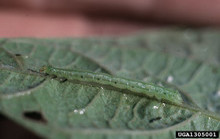
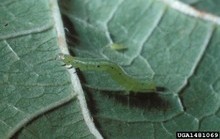
Symptoms
Large or small holes in leaves; damage often extensive; caterpillars are pale green with a white lines running down either side of their body; caterpillars are easily distinguished by the way they arch their body when moving; eggs are laid singly, usually on the lower leaf surface close to the leaf margin, and are white or pale green in color.
Cause
Insect
Comments
Insects overwinter as pupae in crop debris in soil; adult insect id a dark colored moth; caterpillars have a wide host range.
Management
Looper populations are usually held in check by natural enemies; if they do become problematic larvae can be hand-picked from the plants; an organically acceptable control method is the application of Bacillus thuringiensis which effectively kills younger larvae; chemical sprays may damage populations of natural enemies and should and should be selected carefully.
Mexican bean beetle Epilachna varivestis
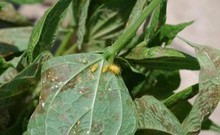
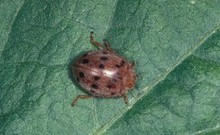
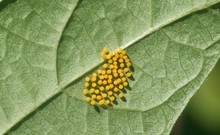
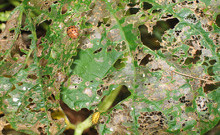
Symptoms
Irregular patches of feeding damage on underside of leaves which causes the top surface of the leaf to dry out, giving the leaves a lacy appearance; insect will also damage flowers and small pods; pods may be damaged so badly that they drop from the plant; adult insect is an orange-brown beetle with black spots; larvae are fat-bodied grubs which taper at the end and are in rows of conspicuous spines
Cause
Insect
Comments
Beetles can decimate bean crops; beetles overwinter as adults and undergo 2-3 generations per year
Management
Some bean varieties may be less attractive hosts for the beetle, e.g. snapbeans are preferred hosts over lima beans; early varieties may escape damage form beetles beetle populations can be reduced by remove overwintering sites such as brush and leaves on the ground; handpick larvae and adults; brush eggs from leaves and destroy; apply insecticidal soap to leaf undersides if infestation is heavy
Stinkbugs (Consperse stinkbug, etc.)
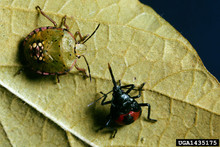
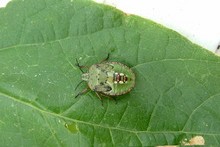
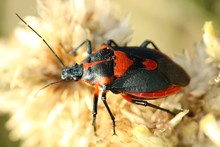
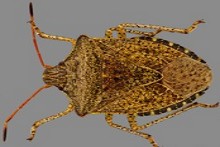
Symptoms
Dark colored pinpricks on fruit surrounded by a lighter area that turns yellow or remains light green; stink bugs often carry pathogens in their mouthparts which can cause secondary infections and decay of fruit; adult insect is shield-shaped and brown or green in color; may have pink, red or yellow markings; eggs are drum shaped and laid in clusters on the leaves; larvae resemble the adults but are smaller.
Cause
Insect
Comments
Adult insects overwinter under leaves, on legumes, blackberries or on certain weeds such as mustard or Russian thistle.
Management
Remove weeds around crop which may act as overwintering sites for stink bugs and practice good weed management throughout the year; organically accepted control methods include the use of insecticidal soaps, kaolin clay and preservation of natural enemies; chemical treatments are not recommended for tomatoes that are to be processed for paste or canning unless secondary infections with other pathogens are a concern.
Category : Mites
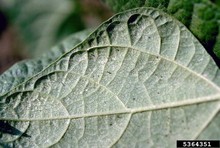
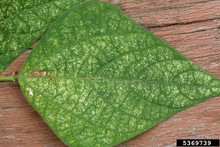
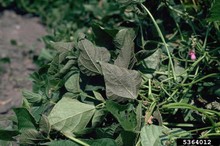
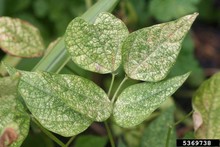
Spider mites (Two-spotted spider mite)
Symptoms
Leaves stippled with yellow; leaves may appear bronzed; webbing covering leaves; mites may be visible as tiny moving dots on the webs or underside of leaves, best viewed using a hand lens; usually not spotted until there are visible symptoms on the plant; leaves turn yellow and may drop from plant.
Cause
Arachnid
Comments
Spider mites thrive in dusty conditions; water-stressed plants are more susceptible to attack.
Management
In the home garden, spraying plants with a strong jet of water can help reduce buildup of spider mite populations; if mites become problematic apply insecticidal soap to plants; certain chemical insecticides may actually increase mite populations by killing off natural enemies and promoting mite reproduction.


Leave a Reply